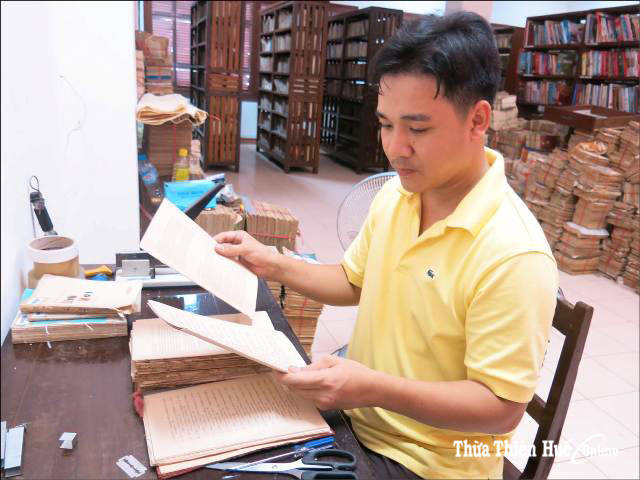
Bui Tu Thanh assiduously restores a book
Quiet work
After graduating from Department of Foreign Languages Education, Hoang Thi Thu Huong started working at Ho Chi Minh Museum in Thua Thien Hue in 1998. Working in Database – Inventory – Preservation Department, Ms. Huong is in charge of monitoring the condition of artifacts. Every day, when starting work in the morning and before leaving in the afternoon, she “pays a visit” to the artifacts in the warehouse and adjusts the temperature and the humidity.
It is a common belief that managing artifacts is simple, but after a talk with Ms. Thu Huong, I realize that the management of artifacts is a scientific process, and each artifact even has… its resume and passport. Ms. Huong said, “After artifacts are evaluated and classified by the Scientific Council, my job is cleaning them finely, sorting them by their material and theme, recording in the registry, saving their inventory and classification numbers, and then arranging them up on shelves. The final step is to write a resume, issue a passport for each artifact, and enter its information in the search system.” Ms. Huong showed me a passport of an artifact in which there is some information including its photo, inventory number, ordinal number, summary of origin, value and its location in the museum.
Graduating from Hue University of Fine Arts after nine years studying there, Hoang Phi Hung, Vice President of the Operation Department of the Le Ba Dang and Diem Phung Thi Art Center, is in charge of preserving the artworks of artist Le Ba Dang. Paintings of Le Ba Dang are multi-material, and many of them are embossed so it is not simple to maintain them in the harsh weather, especially works displayed in the condition of lack of air conditioners and dehumidifiers. That also makes Mr. Hung's job harder. Mr. Hung shared, "Because artist Le Ba Dang's oil paintings are made of multiple materials, they are difficult to preserve and easily affected by the weather. Depending on the extent of damage of each painting, the center has proper treatment. If the damage is minor, I will directly handle it, but for more serious ones, we hire experts to ensure the original value of the work. The advantage is that I was taught how to handle minor damages in artworks by artist Le Ba Dang.
The main duty of Mr. Bui Tu Thanh, librarian of Provincial General Library, is to serve the reader. However, due to the staff shortage, he also does book repairs. “Because of the severe weather condition in Hue and the lack of facilities, a large number of valuable books need restoring. There are neither tools such as cutting, pressing machines, scanners or treatment chemicals nor professional training course; the restoration just ends up re-binding the damaged covers and papers,” shared Mr. Thanh.
Meticulousness
To Ms. Thu Huong, it is not a hard job, but it includes so many steps as the number of artifacts held by Ho Chi Minh Museum in Thua Thien Hue is up to 16,000. Ms. Huong said, "The museum is a place to store artifacts related to President Ho Chi Minh. Each of them has a historical value associated with a story and memory of him, so I cherish them more. Because each collection has only one item, I must be more cautious in work and take care of every single one; over time the artifact becomes so old and fragile that just a strong move can make them broken.
In such extreme weather condition, the role of humans is very important in preserving the works of artist Le Ba Dang. Mr. Hung has to check them regularly, and periodically every three months change the exhibition theme, but sometimes for 20 days, he has to change the paintings when the light and climate has adverse impacts on them. Ms. Dinh Thi Hoai Trai, Director of the Le Ba Dang and Diem Phung Thi Arts Center said, "Preservation of paintings looks very simple, but in fact it requires high careful attention and professional knowledge to detect even a minor damage and how to handle it. Artworks of artist Le Ba Dang combine painting and sculpture, so cleaning them is not simple at all, but it requires skillfulness and gentleness.
Tools for restoring damaged books used by Mr. Thanh are simply needles, threads, pair of tweezers, scalpels, blades, etc. Looking him carefully re-binding damaged books gives me an impression about the meticulousness of this man. Mr. Thanh said, "In restoration of books, impatience and lack of dedication just cause more damage to the books. This work is also very harmful because of frequent exposures to books that are moldy and have lots of bacteria. Therefore, I always try to clean the books before lending them to the reader."
Mr. Thanh also added that some valuable books were too damaged to be restored which made him more anxious. Mr. Thanh wished that the Provincial General Library would have well-equipped rooms for storing precious documents with a view to prolonging their lifespans.
Story and photo: Minh Hien
